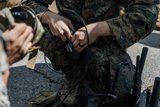Boeing completes software and hardware development of beyond line of sight programme
Boeing today announced that the hardware and software development of its Family of Advanced Beyond Line-of-Sight Terminals (FAB-T) program is nearly complete. Boeing is working closely with the U.S. Air Force to ensure that the FAB-T program can provide protected wideband satellite communications in support of command and control of U.S. nuclear forces.
“The FAB-T program continues to make measurable progress against its planned baseline,” said John Lunardi, Boeing FAB-T vice president and program director. “In April, we integrated the third-generation FAB-T airborne terminal on a test version of the RC-135 Rivet Joint aircraft and successfully demonstrated low-data-rate terminal communications over the air, in flight. The terminal is the first FAB-T user platform to be integrated, and there’s nothing like testing the system in flight to show the program’s continuing success.”
The program, which is in the engineering, manufacturing and development phase, has completed 90 percent of hardware qualification testing, 97 percent of all system software through-code and unit testing, and approximately 30 percent of systems integration and test. Boeing has conducted platform and payload integration testing through over-the-air low-data-rate tests and risk-reduction flight tests. The RC-135 flight test was the second in a series of airborne terminal tests, following a 2009 test with the N404 Massachusetts Institute of Technology/Lincoln Labs test aircraft.
Boeing is working toward a low-rate initial production contract for the Nuclear Command and Control Network Communications System and completing qualification of the third-generation hardware (Block 8) and development of the system’s high-data-rate waveform software.
“Our innovative software development team is working with the Air Force to demonstrate incremental capabilities using FAB-T’s advanced wideband terminal hardware,” said Lunardi. “We’re building and testing each new communications capability for this vital nuclear response mission.”
Boeing will provide the Air Force with a fully capable, affordable system that supports the existing Military Strategic, Tactical and Relay (Milstar) satellite constellation and its ground and airborne command-and-control terminals. The company also will provide terminals for the new AEHF satellite constellation under development in a separate program. The FAB-T products include software-defined radios capable of protected communications, antennas, and associated user interface hardware and software that will provide the government with a survivable and powerful system.
The Boeing FAB-T industry team’s key milestones include the following:
-Boeing conducted multiple intersegment tests in 2010 between a FAB-T Terminal and an AEHF satellite vehicle payload, demonstrating interoperability and compatibility for air, ground and satellite communications.
-In January, the Air Force successfully demonstrated over-the-air, low-data-rate communication between an orbiting Milstar satellite and the more advanced, third-generation (Block 8) FAB-T unit.
-In April, the FAB-T team completed a successful test flight aboard an RC-135 Rivet Joint aircraft, demonstrating in-flight over-the-air communications through an orbiting Milstar satellite to a ground terminal. Aircraft terminal integration and checkout, ground testing, taxi and flight testing further demonstrated the maturity of the FAB-T system.
Source: Boeing
More from Digital Battlespace
-
![Chess Dynamics successfully demonstrates Vision4ce AI-driven tracker]()
Chess Dynamics successfully demonstrates Vision4ce AI-driven tracker
The Vision4ce Deep Embedded Feature Tracking (DEFT) technology software is designed to process video and images by blending traditional computer vision with artificial intelligence (AI) algorithms to present actionable information from complex environments.
-
![Wave Relay devices cleared for security use on commercial systems in industry trend]()
Wave Relay devices cleared for security use on commercial systems in industry trend
Persistent Systems has been cleared by National Security Agency (NSA) to transmit sensitive data on commercial networks. The devices are added to the NSA’s Commercial Solutions for Classified (CSfC) component list which also includes other companies’ products providing the same security.
-
![UK teases cyber spending boost in Strategic Defence Review ahead of “imminent” release]()
UK teases cyber spending boost in Strategic Defence Review ahead of “imminent” release
The release of the UK’s Strategic Defence Review (SDR) has been long promised as mid-year. It is possible it could be as early as 2 June although the UK Ministry of Defence (MoD) continues to play its cards close to its chest.
-
![Intelsat emphasises SATCOM resilience for SOF in contested domains (video)]()
Intelsat emphasises SATCOM resilience for SOF in contested domains (video)
Intelsat outlines how its multi-orbit SATCOM architecture is enhancing connectivity and resilience for special operations forces operating in degraded and contested environments.
-
![US Space Force’s next-generation missile warning system moves forward with $500 million in new contracts]()
US Space Force’s next-generation missile warning system moves forward with $500 million in new contracts
Next-Generation Overhead Persistent Infrared (Next-Gen OPIR) satellites are intended to provide early warning of missile launches from any location worldwide and new ground stations will result in expanded coverage of critical missile warning.
























